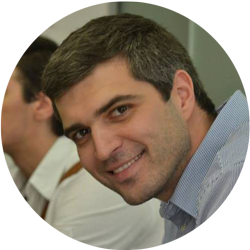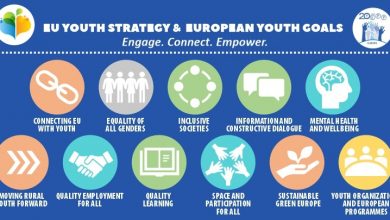EU Youth Strategy 2019 – 2027
The EU Youth Strategy is the most important policy document for young people in Europe. A trainer’s understanding of the strategy is crucial for their work and civic engagement. Reading, discussing and understanding the new EU Youth Strategy is an important perspective that each trainer should have when preparing training. The new strategy puts a strong emphasis on the quality of youth work and youth participation in democratic life. This article provides an overview of the EU Youth Strategy 2019-2027 and makes a reflection on the trainer’s role in working with the document and its successful implementation.

The EU Youth Strategy is the framework for youth policy cooperation and it represents the basis for the youth policies on the EU level. The new strategy builds on the previous youth strategy 2010-2018. The new strategy has been developed by the European Commission with previous long years of preparatory work. The preparatory work for the strategy included the documents: interim evaluation for the period 2010-2015, gathering data for youth report: youth wiki, questionnaires to member states and Youth Forum, Eurostat, Euro barometer survey, various focus groups, and structured dialogue with young people 2017-2018 etc.
The outcomes of this process and findings are outlined in the new European youth strategy that identifies the main trends among young Europeans. The key findings are:
On the positive side, young people’s lives are improving:
– Young people are educated to an increasingly higher level
– More young people are finding employment
– There has been some improvement in the social inclusion of young Europeans.
– Young people appear less prone to risky health behaviors
– Young Europeans are demonstrating an increasing interest in politics and are taking advantage of the new methods of participation offered by modern technology
– Participation in voluntary activities shows an exceptional expansion
However, some challenges persist…
– Some groups of young people encounter difficulties in educational achievement
– Poverty and social exclusion still affect large sections of the youth population
– Obesity and insufficient physical activity pose health risks for an increasing number of young people
– Electoral turnout amongst young Europeans continues to decline and some groups of young Europeans suffer from inequalities:
– Young women and men both face disadvantages but in different areas
– Young Europeans from eastern and southern Europe face comparatively bigger challenges in terms of education, employment, and inclusion
The strategy has three main pillars, which are the core areas of action: engage, connect and empower.
With ENGAGE the EU Youth Strategy aims towards a meaningful civic, economic, social, cultural and political participation of young people.
With CONNECT the strategy aims to connect young people across the EU & beyond to foster voluntary engagement, learning mobility, solidarity, and intercultural understanding.
With EMPOWER the strategy aims to support youth empowerment through quality, innovation, and recognition of youth work.
Besides these three key areas of action, the strategy has 11 Youth Goals. The Youth Goals are the outcome of the Structured Dialogue process in 2017-2018 and they should represent the views of young people from all over Europe. The 11 youth goals that are included as Annex of the strategy are:
- CONNECTING EU WITH YOUTH – Foster the sense of youth belonging to the European project and build a bridge between the EU and young people to regain trust and increase participation.
- EQUALITY OF ALL GENDERS – Ensure equality of all genders and gender-sensitive approaches in all areas of the life of a young person.
- INCLUSIVE SOCIETIES – Enable and ensure the inclusion of all young people in society.
- INFORMATION & CONSTRUCTIVE DIALOGUE – Ensure young people have better access to reliable information, support their ability to evaluate information critically and engage in participatory and constructive dialogue.
- MENTAL HEALTH & WELLBEING – Achieve better mental wellbeing and end the stigmatization of mental health issues, thus promoting social inclusion of all young people.
- MOVING RURAL YOUTH FORWARD – Create conditions that enable young people to fulfill their potential in rural areas.
- QUALITY EMPLOYMENT FOR ALL – Guarantee an accessible labor market with opportunities that lead to quality jobs for all young people.
- QUALITY LEARNING – Integrate and improve different forms of learning, equipping young people for the challenges of an ever-changing life in the 21st century.
- SPACE AND PARTICIPATION FOR ALL – Strengthen young people’s democratic participation and autonomy as well as provide dedicated youth spaces in all areas of society.
- SUSTAINABLE GREEN EUROPE – Achieve a society in which all young people are environmentally active, educated and able to make a difference in their everyday lives.
- YOUTH ORGANISATIONS & EUROPEAN PROGRAMMES – Ensure equal access for all young people to youth organizations and European youth programs, building a society based on European values and identity
The strategy has new novelties that should improve the implementation and effectiveness of the strategy, as well as, there is a continuity for tools that have proved successful.
The main novelties in the new strategy are:
- A renewed EU Youth Dialogue;
- An EU Youth Coordinator;
- Better strategy’s monitoring;
- Tracking of EU funding invested in youth;
- Youth Strategy platform;
- National Activities planners;
- Stronger links with programs;
The continuity is ensured for the following tools:
- Youth wiki;
- EU Youth Report;
- Partnership CoE-EU;
- Dashboard of youth indicators;
- European Youth Portal;
- National Working Groups Dialogue;
The new EU youth strategy 2019-2027 puts a strong focus on the democratic participation of young people in society and European reconstruction. The new strategy has a stronger emphasis on values and principles, it is more political, acknowledges the participatory governance and accountability in a youth policy document. Personal development is still there, but with a civic purpose[2].
Some concerns and questions that have been raised and relevant for sharing are:
- How is the relation of this document with the other strategic frameworks?;
- An alignment between the programs and the Strategy is needed;
Ethical issues? Strong focus in the strategy on VALUES, but consensus on what they are and what they mean is lacking among the member states?;
It is important to mention that in Annex 4, there is a Work Plan for the EU Youth Strategy for 3 years (2019-2021) which provides a closer overview of the implementation plan for the next 3 years.
- Trainer’s role in the EU Youth Strategy 2019 – 2027
The strategy represents one of the most important policy documents for young people in the European Union. It is a document that is built based on long years of research, reports, focus groups, statistical and analytical data for young people. Therefore, first and foremost, it represents a base for relevant knowledge that can be used in a training setting. The strategy provides relevant data for education and training; employment and entrepreneurship; health and well-being; participation; social inclusion; and youth and the world.
When seeing it from a “civic engagement” perspective and the role of trainers in its implementation, the EU Youth Strategy, as a policy document:
- Represents a credible and reliable reference source supported by verified data and facts;
- Provides an overview of the long-term direction of the youth sector in the EU, and it also gives a sense of the programs and budget design for young people;
- Creates space for lobbying and influencing national or local youth strategies; Youth workers and learners can use the document in a national or local setting to convince their Government(s) to align their direction with the direction of the European Union.
- Provides a direction for cross-sectoral partnerships and networks for advocacy and lobbying; Trainers can inspire learners to work in the direction of the Strategy based on the three pillars and/or the eleven youth goals. Each pillar and goal has its own area of youth workers, organizations and networks that trainers and learners can support and/or join;
- It is a tool for a reflection that trainers can use to steer an open discussion with learners and youth workers to harvest their views on the strategy;
Overall, there are many ways that a trainer can use the strategy to increase the awareness of learners about the EU’s commitment to young people. For trainers, it creates space for engagement with a new power paradigm of participation that is embodied in the strategy. Learning how to participate, how to critically think and analyze a policy document, etc. is a process that each trainer needs to go through, to effectively develop and transfer the “civic engagement” competence area. One can see the trainer’s role as being translators (communicators) between young people, policymakers, media, youth workers, parents – in a youth-friendly language.
Why did I choose this tool?
I have chosen to reflect and write about the EU Youth Strategy 2019-2027 because I want to challenge the learner to read, discuss, analyze and truly understand the strategy that is set out for young people in the future. This policy document contains a lot of useful and relevant data of young people that can be used in training settings; it also describes the paradigm that the European Union is having for the future of young people. And lastly, I felt it is important to stress the EU youth strategy because the democratic participation and civic engagement have a strong emphasis, and the competence “being civically engage” as part of this youth strategy becomes very relevant.
Suggested Reflection Questions
Other Ways to Practice:
Depending on the aims of the training, the trainer can use the EU Youth Strategy to steer discussion for education and training; employment and entrepreneurship; health and well-being; participation; social inclusion; youth and the world. These are the main topics that are analyzed and researched in the EU Youth Strategy that the trainer can explore and use in a training set. Methods for achieving a fruitful discussion and learning are different: smaller groups, partners sharing, open discussion, etc.
The smartest way to keep people passive and obedient is to strictly limit the spectrum of acceptable opinion but allow very lively debate within that spectrum – Noam Chomsky, the Common Good
Exercise
A trainer can do different things with this article and the EU Youth Strategy. Each pillar has its own components that should be understood and further discussed with other learners. This learning process can be done in smaller groups by reading and sharing what was understood. Important aspects of the exercises and the reflection is to ask yourself (and the learners) about:
- How does this pillar (ex. ENGAGE) relate to my local community? Do I see it implemented around me by young people and other learners? How can I contribute to the successful implementation of this pillar?
- You can do the same with the other two pillars (CONNECT and EMPOWER).





